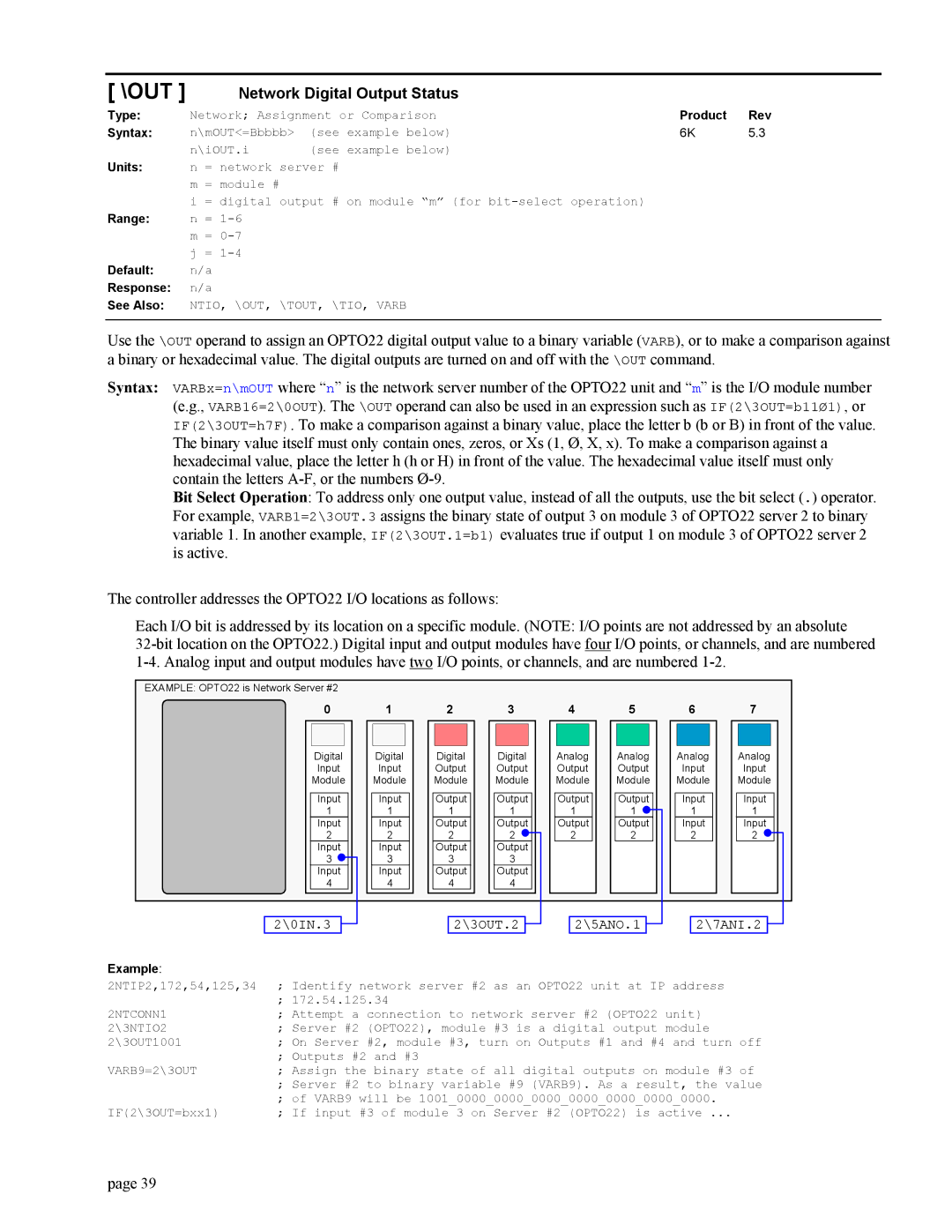
[ \OUT ] | Network Digital Output Status |
|
| ||
Type: | Network; Assignment or Comparison | Product | Rev | ||
Syntax: | n\mOUT<=Bbbbb> | (see | example below) | 6K | 5.3 |
| n\iOUT.i | (see | example below) |
|
|
Units: | n = network server # |
|
|
| |
| m = module # |
|
|
|
|
| i = digital output # | on module “m” (for |
|
| |
Range: | n = |
|
|
|
|
m=
Default: | n/a |
Response: | n/a |
See Also: | NTIO, \OUT, \TOUT, \TIO, VARB |
Use the \OUT operand to assign an OPTO22 digital output value to a binary variable (VARB), or to make a comparison against a binary or hexadecimal value. The digital outputs are turned on and off with the \OUT command.
Syntax: VARBx=n\mOUT where “n” is the network server number of the OPTO22 unit and “m” is the I/O module number (e.g., VARB16=2\0OUT). The \OUT operand can also be used in an expression such as IF(2\3OUT=b11Ø1), or IF(2\3OUT=h7F). To make a comparison against a binary value, place the letter b (b or B) in front of the value. The binary value itself must only contain ones, zeros, or Xs (1, Ø, X, x). To make a comparison against a hexadecimal value, place the letter h (h or H) in front of the value. The hexadecimal value itself must only contain the letters
Bit Select Operation: To address only one output value, instead of all the outputs, use the bit select (.) operator. For example, VARB1=2\3OUT.3 assigns the binary state of output 3 on module 3 of OPTO22 server 2 to binary variable 1. In another example, IF(2\3OUT.1=b1) evaluates true if output 1 on module 3 of OPTO22 server 2 is active.
The controller addresses the OPTO22 I/O locations as follows:
Each I/O bit is addressed by its location on a specific module. (NOTE: I/O points are not addressed by an absolute
EXAMPLE: OPTO22 is Network Server #2
0 | 1 | 2 | 3 | 4 | 5 | 6 | 7 |
Digital | Digital | Digital | Digital | Analog | Analog | Analog | Analog |
Input | Input | Output | Output | Output | Output | Input | Input |
Module | Module | Module | Module | Module | Module | Module | Module |
Input | Input | Output | Output | Output | Output | Input | Input |
1 | 1 | 1 | 1 | 1 | 1 | 1 | 1 |
Input | Input | Output | Output | Output | Output | Input | Input |
2 | 2 | 2 | 2 | 2 | 2 | 2 | 2 |
Input | Input | Output | Output |
|
|
|
|
3 | 3 | 3 | 3 |
|
|
|
|
Input | Input | Output | Output |
|
|
|
|
4 | 4 | 4 | 4 |
|
|
|
|
| 2\0IN.3 |
|
| 2\3OUT.2 |
|
| 2\5ANO.1 |
|
| 2\7ANI.2 |
|
|
|
|
|
| |||||||
Example: | ; Identify network server #2 as an OPTO22 unit at IP address |
| |||||||||
2NTIP2,172,54,125,34 |
| ||||||||||
2NTCONN1 | ; 172.54.125.34 |
|
|
|
|
|
|
|
| ||
; Attempt a connection to network server #2 (OPTO22 unit) |
| ||||||||||
2\3NTIO2 | ; Server #2 (OPTO22), module #3 is a digital output module |
| |||||||||
2\3OUT1001 | ; On Server #2, module #3, turn on Outputs #1 and #4 and turn off |
| |||||||||
VARB9=2\3OUT | ; Outputs #2 and #3 |
|
|
|
|
|
|
|
| ||
; Assign the binary state of all digital outputs on module #3 of |
| ||||||||||
;Server #2 to binary variable #9 (VARB9). As a result, the value
;of VARB9 will be 1001_0000_0000_0000_0000_0000_0000_0000.
IF(2\3OUT=bxx1) | ; If input #3 of module 3 on Server #2 (OPTO22) is active ... |
page 39
